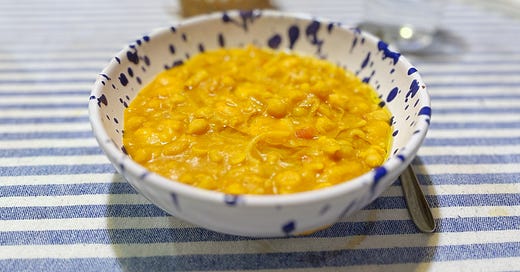Don’t know what to do with all the random bits of leftover pasta in various shapes lingering in your cupboard? Romans use those bits, commonly called pasta mista, to make this hearty chickpea stew, though of course you could use any small pasta. Flavored with garlic, rosemary, anchovies, and tomatoes, It’s pretty much exactly what you want to eat on a cold winter evening.
Pasta e ceci is one of those humble, home-style dishes that rarely turns up on restaurant menus, but everyone’s mother or grandmother makes it at home—and each family has their own version. It’s no wonder—Italians have been playing with the recipe for millennia. As
writes in her book, Pomegranates & Artichokes: Recipes and memories of a journey from Iran to Italy, “Unsurprisingly, a soup (or minestra) with chickpeas and pasta is as ancient as recipes can be—mentioned by Horace in first century BC Rome, and found with regional differences across provinces such as Basilicata and Puglia.”Saghar’s version of the recipe starts with a soffritto of onion, carrots, and celery, but I often use vegetable or seafood broth that I’ve cooked separately and strained. Famed Italian chef Max Mariola’s version uses the cooking water from the chickpeas instead of broth, and I’ve done that too. Sometimes I add clams, mussels, and tiny shrimp at the end, which makes it richer. Or you could take Saghar’s advice and toss in some thinly sliced guanciale or pancetta in place of the anchovies.
Whatever you do, make sure that the chickpeas have enough time to cook before you add them to the stew. If using dry chickpeas, soak them in plenty of water overnight, then drain them and boil them in a pot with fresh water for 60-90 minutes. Uncooked chickpeas contain mildly toxic substances, so discard the water you use to soak them and use fresh water to boil them.
Pasta e Ceci
Serves 4-6
Ingredients:
200 grams (7 ounces) dry chickpeas
3 cloves of garlic, peeled and crushed
1/2 can of whole peeled tomatoes
4-5 anchovies
A few branches of rosemary
1 chili or a pinch of chili flakes, to taste
200 grams (7 ounces) pasta mista or other small pasta
1.5 liters (about 6 cups) vegetable or seafood broth
Olive oil
Directions:
If using dry chickpeas, soak them overnight. Then drain them and rinse with cold water. Fill a pot with fresh water and boil them on medium to high heat for 60 to 90 minutes. They should be quite soft, but keep their shape.
If you plan to add seafood, clean and prepare it now. Steam the clams in a pan with olive oil, garlic, parsley stems and chili until they open. Add a splash of wine wine if you like and let it evaporate. When all the clams are open, transfer them to a bowl and set them aside. Do the same with the mussels. Peel the shrimp and remove their heads and set the tails aside.
In a larger pot, heat some olive oil and add the garlic, anchovies, rosemary, and chili and stir around for a few minutes so they release their flavors in the oil. Using a wooden spoon, break up the anchovies into tiny pieces. Remove the garlic and rosemary. If you’re using a large chili, you might want to remove that too. Add the peeled tomatoes and crush them using a wooden spoon.
Using a slotted spoon, transfer about half of the cooked chickpeas to the pot. Put the rest of the chickpeas into a food processor or blender, add some of the cooking water or broth, and blend them until smooth. Add the pureed chickpeas and the broth to the pot. I usually do this bit by bit so I can control the consistency and I never measure the amount of liquid I put into the pot. I just make sure the chickpeas are completely covered and then some. It should be quite soupy at this point, but it will thicken up. Let it simmer over medium heat for a few minutes. I usually don’t need to add any salt because the anchovies are very salty, but you should adjust to taste.
Then turn up the heat and add the pasta. Set a timer for the cooking time on the package, roughly 9-11 minutes. Stir often to make sure pasta doesn’t stick to the bottom or sides of the pot. It should thicken up, but if it’s getting too dry, add more broth. I generally like it to be on the thick side, but still soupy. Adjust to suit your personal preference. When the pasta has a minute or two left, I add the shrimp and let them cook in the stew. Then I add the clams and mussels, if using.
Let the stew rest for a couple of minutes. Serve with a drizzle of olive oil.
Further Reading
Saghar’s book, Pomegranate & Artichokes, is available for sale on Amazon and I highly recommend it. You can read my interview with her here. Also be sure to check out her Substack
.You can watch Max Mariola’s video recipe of Roman-style pasta e ceci here. It’s in Italian, but has English subtitles.
Another cozy soup I plan to try making this week is this bean and farro soup from Garfagnana by
, a Tuscan cookbook author who teaches cooking lessons in her home in Colle Val d’Elsa. If you want more Tuscan recipes and travel tips, subscribe to her newsletter .Check out all the recipes in the New Roman Times’ archives here.






Yes! Love pasta e ceci. I often make it for all of us. I use chicken broth and only a touch of tomatoes but give me all those anchovies.